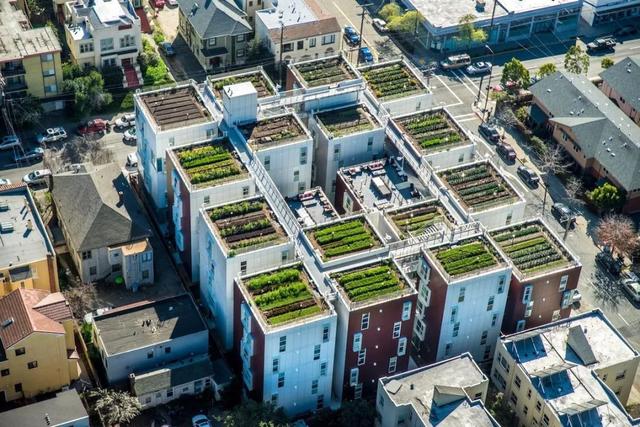(本文選自《經濟學人》20200704期)
背景介紹:
新加坡是位于東南亞的一個島國,國土面積僅爲720平方公裏。而作爲農田的土地面積更是少得可憐,如今僅爲國土面積的不到1%(即大約不到7平方公裏)。由于土地資源有限,新加坡的糧食大多靠進口。但如今,隨著疫情大流行,全球糧食供應也受到了影響,于是新加坡的農民紛紛開始在屋頂種起菜來。
The rise of the rooftop farmer
越來越多人在屋頂種菜
Government subsidies make excellent fertiliser
政府補貼成爲了最好的肥料
Benjamin Swan’s farm is on the fourth floor of an office building in an industrial part of Singapore. To see his crops, visitors are escorted past a door unlocked with a thumbprint and through an airlock. (“Our air is certified,” says an assistant.) Room after room is filled with plumes of kale and lettuce, evenly spaced on long trays stacked in floor-to-ceiling racks.
本傑明·斯旺的農場位于新加坡工業區一幢辦公樓的四樓。想要看看他的莊家,參觀者必須通過一扇裝有指紋鎖的大門以及一道氣閘室。(一位助理說:“內部空氣已經過認證。”)一間間房裏種滿了羽衣甘藍和生菜,它們均勻地生長在長長的托盤裏,架子上的一個個托盤從地面一直堆疊至天花板。
Cables snake across the racks and ceilings, like an electrical root system. LED lights, designed to emit only the part of the electromagnetic spectrum that plants can absorb, cast a purple glow. The greens are planted in a substrate—not a speck of soil is in sight.
電線蜿蜒曲折地穿過架子和天花板,仿佛電子根系一般。經設計的LED燈僅會發出植物所能吸收的那部分電磁波譜,即紫色的微光。綠色植物被種植在看不到一丁點土壤的基質中。
Singapore is a hymn to concrete and metal. But look closely and you can see farms mushrooming across the city-state: on the roofs of malls and car parks, in schools, warehouses and even the site of a former prison. This is new.
新加坡是一首鋼筋混凝土的贊歌。但你仔細觀察便會發現,城市中的農場正如雨後春筍般湧現:在商場和停車場的屋頂、在學校、在倉庫,甚至在廢棄的監獄裏。這一景象是前所未有的。
Commercial farming in the land-scarce city was phased out in the 1970s and 1980s. “Unlike virtually any other country on earth, Singapore has lost a generation of farmers,” says Bradley Busetto of the Global Centre for Technology, Innovation and Sustainable Agriculture, a UN outfit based in Singapore.
20世紀70年代和80年代,商業農業逐漸被土地稀缺的城市所淘汰。全球技術、創新與可持續農業中心(一家總部位于新加坡的聯合國機構)的布拉德利·布塞托說:“不同于世界其他國家,新加坡已經失去了一代農民。”
Today just 720 square kilometres of land, less than 1% of Singapore, is set aside for farms. But a new crop of entrepreneurs are betting on rewards from finding idle spaces where lettuces may be coaxed to life. Since 2014, 31 commercial urban farms have sprouted.
如今,在新加坡720平方公裏的國土面積中,僅有不到1%的土地被用作農田。但是,一批新的企業家正將賭注押在了可用于培育生菜的閑置空間上。自2014年以來,全國已經湧現出31家城市商業農場。
The government is delighted. Singapore imports more than 90% of its food. It is “extremely vulnerable to fluctuations in our food availability that may be brought about by climate change, disease outbreaks and global food situations,” says Low Li Ping of the Singapore Food Agency. In 2019 the government said the country should produce 30% of its food by 2030.
政府對此也很樂見。在新加坡,超過90%的糧食靠進口。新加坡糧食署的洛李平說:“氣候變化、疾病爆發以及全球糧食形勢極易對我國的糧食供應造成影響。”2019年,新加坡政府表示,到2030年,國內糧食産量將占糧食需求總量的30%。
It has put its money where its mouth is. Before the pandemic the government had pledged S$207m ($149m) to help farmers boost productivity and to spur research. In April the government, spooked by the pandemic’s (small) disruptions to global markets for food, promised an extra S$30m to help farmers grow more in the next six to 24 months, and invited urban farmers to apply to rent the roofs of nine government-owned car parks. Mr Swan, the indoor kale farmer, credits the government with helping to fund his company’s R&D and introducing him to investors.
政府已經兌現了承諾。在新冠疫情爆發前,政府承諾向農民提供2.07億新元(合1.49億美元),以幫助農民提高生産力並推動農業相關研究。今年4月,出于對全球糧食市場受疫情影響(雖然影響甚微)的恐慌,政府承諾將在未來6至24個月內額外提供3000萬新元,以幫助農民種植更多作物,並且鼓勵城市農民申請租用9個歸政府所有的停車場的屋頂。室內羽衣甘藍種植者斯旺表達了對政府的感謝,政府爲他的公司提供了研發資金,並爲他介紹了一些投資者。
Such help is gratefully received. Farming in the city can be expensive. Property and labour are costly. To maximise space, farmers stack plants. Some go inside, which means losing a free and plentiful input—the sun—but allows greater control of the environment. “Every room is its own climate,” says Sven Yeo of Archisen, an indoor farm that tinkers with temperature, humidity, carbon dioxide, light, water and nutrients to produce tastier lettuce, sorrel and chard.
人們欣然接受了政府的資助。城市裏種地成本高昂,土地和勞動力都很昂貴。爲了能夠最大限度地利用空間,農民們會將作物堆疊種植。一些農場走進了室內,室內農場意味著免費而充足的陽光將不複存在,但這樣一來能夠更好地控制環境條件。室內農場阿奇森通過調節溫度、濕度、二氧化碳含量、光照、水分和營養來生産更美味的生菜、酸模和甜菜。阿奇森的斯旺·約說:“每個房間都有自己的氣候。”
The technology does not come cheap, but it does allow for more frequent and bountiful harvests. Mr Swan says his farm yields 178 times more lettuce per square metre than a traditional one. It started production in 2015 and broke even for the first time in 2018. His labours are bearing fruit.
這項技術並不便宜,但確實能夠促進作物的生長並提高收成。斯旺說,他的農場每平方米的生菜産量比傳統農場高178倍。自2015年投入生産以來,2018年首次實現了盈虧平衡。他的努力正在結出碩果。
重難點詞彙:
escort [ˈeskɔːrt] vt. 護送;陪同
hymn [hɪm] n. 贊美詩;贊歌
mushroom [ˈmʌʃrʊm] n. 蘑菇;暴發戶 v. 迅速增加
coax [koʊks] v. 哄騙;勸誘
sprout [spraʊt] v. 發芽;長芽
fluctuation [ˌflʌktʃuˈeɪʃn] n. 起伏;波動
disruption [dɪsˈrʌpʃn] n. 擾亂;打亂;中斷
bountiful [ˈbaʊntɪfl] adj. 豐富的;慷慨的
立足亞洲 面向世界
傳遞論壇最新動態 促進亞洲深度合作
全球重要對話的傳達者 亞洲共同發展的瞭望者
